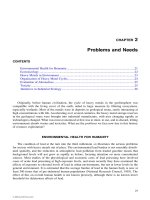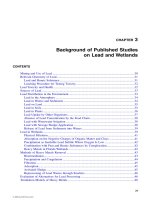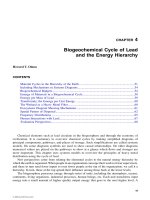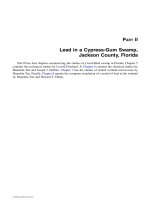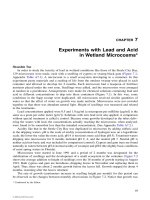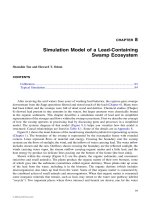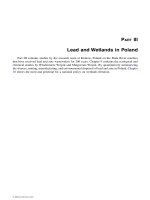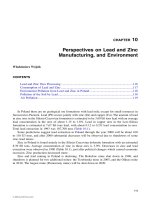Speciation of heavy metals in bottom sediments of Karra river, Nepal
Bạn đang xem bản rút gọn của tài liệu. Xem và tải ngay bản đầy đủ của tài liệu tại đây (307.19 KB, 6 trang )
SPECIATION OF HEAVY METALS IN BOTTOM
SEDIMENTS OF KARRA RIVER, NEPAL
Sadhana Pradhanang
ABSTRACT
The chemical forms of copper and zinc have been determined using the
fractional scheme of Tessier et al. (1979) in the bed sediments of Karra River,
Hetauda, Nepal. The sequential extraction revealed that high percentage of metals
was associated in the residual fraction (upstream and downstream). However, in most
of the sites in the industrial belt, a significant proportion of metal was associated with
the non-residual fraction (64% in Cu and 45% in Zn) which can be remobilized and
released to the environment by various physical-chemical processes. This indicates
influence of anthropogenic activities on the Karra River.
Key words: Chemical form, bed sediment, Karra, industrial belt, anthropogenic
INTRODUCTION
Sediment is an important source of heavy metal pollutants in a river
ecosystem as they have a long residence time (Forstner and Wittmann, 1983).
Sediment serves as a sink where contaminants can be stored and also act as a source
of the pollutants to the overlying water and to the aquatic organism of the ecosystem.
Therefore, it serves as the carrier and reservoir of the heavy metals and reflects the
quality of the system (Chapman and Wang, 1999). Heavy metals are not permanently
fixed on sediments and can be released back to the water column by changes in
environmental conditions, such as pH, redox potential, and chelation in the aquatic
environment (Forstner, 1987; Sutherland and Tack, 2007; Rath, et al., 2009). It
provides a qualitative idea about reactivity and mobility of total metals present in
sediments (Vicente-Beckett, 1991). The mobility of metals in the environment
depends on their chemical forms or type of the binding of the element. Sediments are
good indicator of water quality and reflect the effects of anthropogenic release.
Numerous studies have been conducted on heavy metal pollution from different
anthropogenic sources (Ma and Rao, 1997). It is important to know not only the total
metal content but also the site of the metal in the sediment matrices (exchangeable,
carbonate, Fe-Mn oxides, organic, residual fraction) which probably indicates the
occurrence of different pollution sources (Jain et al., 2004).
The method of fractionation of trace metals in sediments are based on
sequential extraction procedures. Sequential extraction is used to determine
geochemical partitioning of heavy metals in soil, sediments and sludge (Howard
and Shu, 1996). So it is widely used to estimate the amounts and proportions of
metals in soil and to predict bio-availability and metal leaching (Jalali and
Khanlari, 2008). The unbuffered salts, weak acids, reducing agents, oxidizing
agents, and strong acids are generally used as extractant in sequential extraction
(Filgueiras, 2002; Tessier and Cambell, 1987). In the present study, sequential
extraction was carried out in five step procedures as proposed by Tessier et al. (1979)
Dr. Pradhanang is an Associate Professor at Central Department of Environmental Science,
T.U., Kirtipur, Nepal.
268 SPECIATION OF HEAVY METALS IN BOTTOM ...
which was followed to determine the partitioning of the trace metals Cu and Zn, The
five step geochemical fractions including exchangeable, carbonates (acid-soluble),
iron-manganese oxide bound (reducible), organic matter bond (oxidisable) and
residual fractions (ssilicate fraction).
MATERIALS AND METHODS
SAMPLING
A total 12 sampling sites for river bed sediment samples were selected
along the bank of the Karra River, Hetauda, Nepal. The samples selected from its
upstream, industrial belt and downstream portions of the Karra River. The
sediment samples were collected in the month of May 2012. Bed sediment
samples were collected manually with the help of plastic scraper and spatula from
the uppermost 5 to 10 cm of the river bank where flow was low. Three random
samples were taken from each site, which were homogenized and composite
samples were stored in plastic bag with zip lock.
METAL FRACTIONATION
Air dried sediments samples were ground using a mortar pestle to a size
about 63µm and subjected to the following extractions. All the extractions, except the
final digestion, were conducted in 50 ml polypropylene centrifuge tubes to minimize
losses of solid materials. After each successive extraction, the supernatant was
separated by centrifuging at 7000 rpm for 30 minutes. The supernatant obtained in
each of the extractions were collected. The residue was washed with 10 ml milli-Q
water followed by centrifugation for 1 hour before the next extraction. In the
extraction two metals (viz; Cu, Zn) were analyzed by five steps sequential
extraction procedure proposed by Tessier et al. (1979).
Exchangeable: One gram sediment sample was extracted at room
temperature for one hour with 8 ml of 1M MgCl2 (pH 7.0) with continuous agitation.
Bound to carbonates: The residue obtained from step (1) was leached at
room temperature with 8 ml of 1.0 M sodium acetate adjusted to pH 5.0 with
acetic acid. The mixture was agitated for 5 hours.
Bound to Fe-Mn Oxides: The residue obtained from step (2) through
continuous agitation at 96°C with 20 ml of 0.04M NH2OH.HCl in 25% (v/v)
acetic acid for 6 hours.
Bound to organic matter: The residue obtained from step (3), 3 ml of
0.02M HNO3 and 5 ml of 30% H2O2 were added and pH adjusted to pH 2.0 with
HNO3. The solution was agitated at 96°C for 2 hours and 3 ml of 30% H2O2 (pH
2 with HNO3) was added and sample was again agitated for 3 hours. After
cooling, 5 ml of 3.2 M ammonium acetate in 20% (v/v) HNO3 was added. The
sample was diluted to 20 ml and agitated continuously for 30 minutes. The filtrate
obtained in each step of the extraction was analyzed for heavy metals.
Residual: Residual obtained from step 4 was digested with
HF/HNO3/HClO4 mixture. 100 mg of residue was taken in a Teflon beaker and 20 ml
of acid mixture of HF, HNO3 and HClO4 (in the ratio 7:3:1) was added. The Teflon
beaker was placed in bomb digestion unit and heated 100°C for 2 hours. After
cooling, volume was made up to 250 ml by adding milli-Q water. Moreover, to ensure
TRIBHUVAN UNIVERSITY JOURNAL, VOLUME. XXVIII, NUMBERS 1-2, DEC. 2013
269
the comparison of total metals to residual fraction, the procedure for the residual
fraction was same to the method for the total metal determination.
The total metal concentrations were also determined by the acid
digestion method using HF, HNO3 and HClO4 in the ratio of 7:3:1.
METAL ION ANALYSIS
Metal ion concentrations in different extracts were determined by
Shimadzu Atomic Absorption spectrophotometer (model AA-6000) using airacetylene flame. Quantification of metals was based upon calibration of standard
solution of respective metals. These calibration curves were determined several
times during the period of analysis. The precision of the metal analysis was
controlled by including triplicate samples in analytical batches and blank. The
detection limits of copper and zinc are 0.1µgL-1, respectively.
RESULTS AND DISCUSSION
Copper was observed in varying proportion in all phases in the
upstream of the Karra River. Cu was found to be 78.6% of the total metal (69.3
mg/kg) which were predominantly in the residual form (Fig. 1). Much lower
concentration were associated with exchangeable and carbonate fractions of the
total metal. The contribution of Fe-Mn oxides and organic fraction to total
metal was 6.3% and 3.4% (Fig. 1).
In the industrial belt, Cu fractions were distributed in exchangeable
(6%), carbonate (5.5%), Fe-Mn oxides (26.3%), organic (27.0%) and residual
(35.1%) of the total metal (312 mg/kg). For Cu, bound to organic matter (27%)
was the highest due to the high affinity of Cu for organic matter (McGrath, and
Quevanviller, 1996). Large variation of Cu percentage could be found in
different fractions at the different sites of the industrial belt. The maximum
fraction was bound to organic fraction as well as reducible fraction. Results of
the downstream samples have shown that percentage of Cu extracted in
different steps are as: exchangeable (1.8%), carbonate (1.5%), Fe-Mn oxides
(9.9%), organic (7%) and residual (79.8%) of the total metal (264 mg/kg).
Zinc is one of the most commonly occurring heavy metals which are soluble
and mobile under acidic condition. Zinc enters surface waters mostly from metals
treatment plants and chemical plants. The results show that in the upstream of the
Karra River, Zn concentrations were 3.8% and 4.9% of the total metal (67.48 mg/kg)
in exchangeable and carbonate fraction, respectively. Concentration of Zn at the
upstream has been found to differ in Fe-Mn oxides and organic and residual fractions
(Fig. 1). The concentration was high in the Fe-Mn oxide fraction (32.9%) and much
lower (2.4%) in the organic fraction whereas the residual fraction was 56.0% of the
total metal. In the industrial belt, under different fractions, percentage of total Zn
extracted were 5.3%, 8.9%, 22.0%, 8.8% and 55%, respectively in exchangeable,
carbonate, Fe-Mn oxides, organic and residual fraction. In the non–residual fraction,
the mean concentration of Cu (64%) and Zn (45%) were found to be the highest of the
total metal. High Zn fraction of Fe-Mn oxide indicates anthropogenic origin. In the
downstream, high concentration of Zn (50%) was found in residual of the total metal
270 SPECIATION OF HEAVY METALS IN BOTTOM ...
(1396 mg/kg). The general association of Zn was in the decreasing order: residual >
Fe-Mn oxides > organic > carbonate > exchangeable.
Zn
100%
75%
50%
25%
0%
Ex-M
Upstream
Carb-M
Industrial belt Down stream
Ox-M
Or-M
Res-M
Figure1: Metal fraction in bed sediments of the Karra River (Exchangeable,
carbonate, Fe-Mn oxide, organic and residual).
RECOVERY OF THE METAL
The accuracy of the sequential extraction procedure, recovery values (%)
were calculated by comparing the sum of five- steps sequential extraction
procedure (exchangeable, carbonate, reducible, organic and residue) with the total
metal concentration.
The recovery of the sequential extraction was calculated as follows:
∑ nSequential extraction
Recoveryn =
Total metal digestion
x
100
TRIBHUVAN UNIVERSITY JOURNAL, VOLUME. XXVIII, NUMBERS 1-2, DEC. 2013
271
The results of recovery showed in Table 1 which indicates that sums of
the five fractions with the good recoveries (92.21-106.29%).
Table1: Recovery of the metals
Cu
Sum of
Total
the
metal
Sample extraction (mg/kg)
steps of
sites
metal
(mg/kg)
US1
73.11
70.42
US2
65.54
70.09
IB1
128.08
130.89
IB2
71.70
74.87
IB3
108.92
104.81
IB4
218.96
230.86
IB5
607.17
657.89
IB6
1165.93
1142.52
IB7
711.50
732.65
IB8
198.17
189.99
IB9
106.34
110.97
IB10
91.51
89.96
IB11
174.66
182.13
IB12
169.33
180.26
DS1
316.52
329.17
DS2
211.60
207.76
CONCLUSION
Recovery
%
103.82
93.50
97.85
95.77
103.92
94.85
92.29
102.05
97.11
104.31
95.82
101.72
95.90
93.93
96.16
101.85
Sum of
the
extraction
steps of
metal
(mg/kg)
47.88
87.08
64.16
37.69
50.07
161.07
200.47
282.01
143.19
845.46
267.06
851.26
1476.82
1810.09
770.37
2021.61
Zn
Total
metal
(mg/kg)
Recovery
%
52.67
93.79
68.26
35.46
49.08
172.18
218.52
305.21
154.51
946.01
290.77
840.39
1444.50
1989.10
835.41
1987.77
90.91
92.85
94.00
106.29
102.02
93.55
91.74
92.40
92.67
89.37
91.85
101.29
102.24
91.00
92.21
101.70
The Karrra River is used as a water recreational, washing and agricutural
purposes. A number of industries do not have proper waste water treatment plant
facilities and waste goes directly or indirectly into the Karra River and thus the river is
more or less becoming a dumping site of a variety of organic and inorganic chemicals.
A sequential extraction procedure was used to fractionate, Cu, and Zn
present in twelve sediment samples. The results of the present study indicate that
residual fraction is the most dominant fraction for all the metals. However, in
most of the sites in the industrial belt, a significant proportion of metal was
associated with the non-residual fraction. This indicates influence of
anthropogenic activities on the Karra River. In the upstream of the Karra river,
high concentration of metal present are in inert phase (residual), being detrital and
of lattice origin (Salomons and Forstner, 1980). The residual fraction was the
most abundant fraction for all the metals in the sediment studied. A significant
amount of Zn, and Cu was associated with the non-residual fractions in industrial
belt studied indicating that this metal was potentially more bio-available than
other metals. The low percentage of heavy metals in the exchangeable fraction
suggests week bioavailability of metal in this environment.
272 SPECIATION OF HEAVY METALS IN BOTTOM ...
WORKS CITED
Chapman, P.M., Wang, F.Y. (1999). Appropriate applications of sediments
quality values for metals and metalloids. Environmental Science and
Technology. 33:3937-3941.
Filgueiras, A.V., Lavilla, I., Bendicho, C. (2002). Chemical sequential extraction for
metals partitioning in environmental solid samples. Journal of
Environmental Monitoring. 4:823-857.
Forstner, U. (1987). In Metal Speciation, Separation and Recovery. Lewis
Publishers, Chelsea.
Forstner, U., Wittman, G.T. (1983). Metal Pollution in the Aquatic Environment.
Springer Verlag, Berlin.
Gadde, R.R. and Laitinen, H.A. (1974). Studies of heavy metal adsorption by hydrous
iron and manganese oxides. Analytical Chemistry. 46:2022- 2026.
Howard, J.L. and Shu, J. (1996). Sequential extraction analysis of heavy metals
using a chelating agent (NTA) to counteract resorption. Environmental
Pollution. 91:89-96.
Jain, C. K., Singhal, D.C., and Sharma, M.K. (2004). Adsorption of zinc on bed
sediment of River Hindon: adsorption models and kinetics. Journal of
Hazardous Materials. 114:231-239.
Jalali, M. & Khanlari, Z.V. (2008). Environmental contamination of Zn, Cd, Ni,
Cu, and Pb from industrial areas in Hamadan Province, western Iran.
Environmental Geology. 55:1537–1543.
Ma, L.Q., and Rao, G.N.(1997). Chemical fractionation of cadmium, copper, nickel and
zinc in contaminated Soils. Journal of Environmental Quality. 26: 259-264.
McGrath, D., Quevanviller, P. (1996). Application of single and sequential
extraction procedures to polluted and unpolluted soils. Science of the
Total Environment. 178: 37-44.
Rath, P., Panda, U.C., Bhatta, D., Sahu, K.C. ( 2009) Use of sequential leaching,
mineralogy, morphology and multivariate statistical technique for quantifying
metal pollution in highly polluted aquatic sediments-a case study: Brahmani
and Nandira Rivers. India Journal of Hazardous Materials. 163: 632–644.
Salomons, W., Forstner, U. (1984). Metals in Hydrocycle. Springer, New York.
Sutherland, R.A., Tack, F.M.G. (2007). Sequential extraction of lead from grain
size fractionated river sediments using the optimized BCR Procedure.
Water Air Soil Pollution. 84: 269–284.
Tessier, A., Campbell, P.G.C. (1987). Partitioning of trace metals in sediments:
relationships with bioavailability. Hydrobiologia, 149: 43-42.
Tessier, A., Cambell, P.G.C., Bisson, M.X. (1979), Sequential extraction
procedure for the speciation of particulate trace metals. Analytical
Chemistry. 51: 844-851.
Vicente-Beckett, V.A., Pascual, C.B., Kwan, C.S., Beckett. (1991). Levels and
distribution of trace metals in sediments of Laguna Lake (Philippines) and its
tributary rivers. International Journal of Analytical Chemistry. 45: 101-116.

